Abstract
Hereditary geniospasm is an unusual movement disorder causing episodes of involuntary tremor of the chin and the lower lip. Episodes typically start in early childhood and may be precipitated by stress, concentration, and emotion. Hereditary geniospasm is inherited as an autosomal dominant trait, and its cause is not known. We report the results of a genomewide genetic linkage study in a four-generation British family with hereditary geniospasm. Positive two-point LOD scores were obtained for 15 microsatellite markers on the peri-centromeric region of chromosome 9. A maximum two-point LOD score of 5.24 at theta = .00 was obtained for the marker D9S1837. Construction of haplotypes defined an interval of 2.1 cM between the flanking markers D9S1806 and D9S175, thus assigning one locus for hereditary geniospasm to the proximal long arm of chromosome 9q13-q21. Hereditary geniospasm in a second British family is not linked to this region, indicating genetic heterogeneity. These findings may have implications for other inherited focal movement disorders that as yet remain unmapped.
Full text
PDF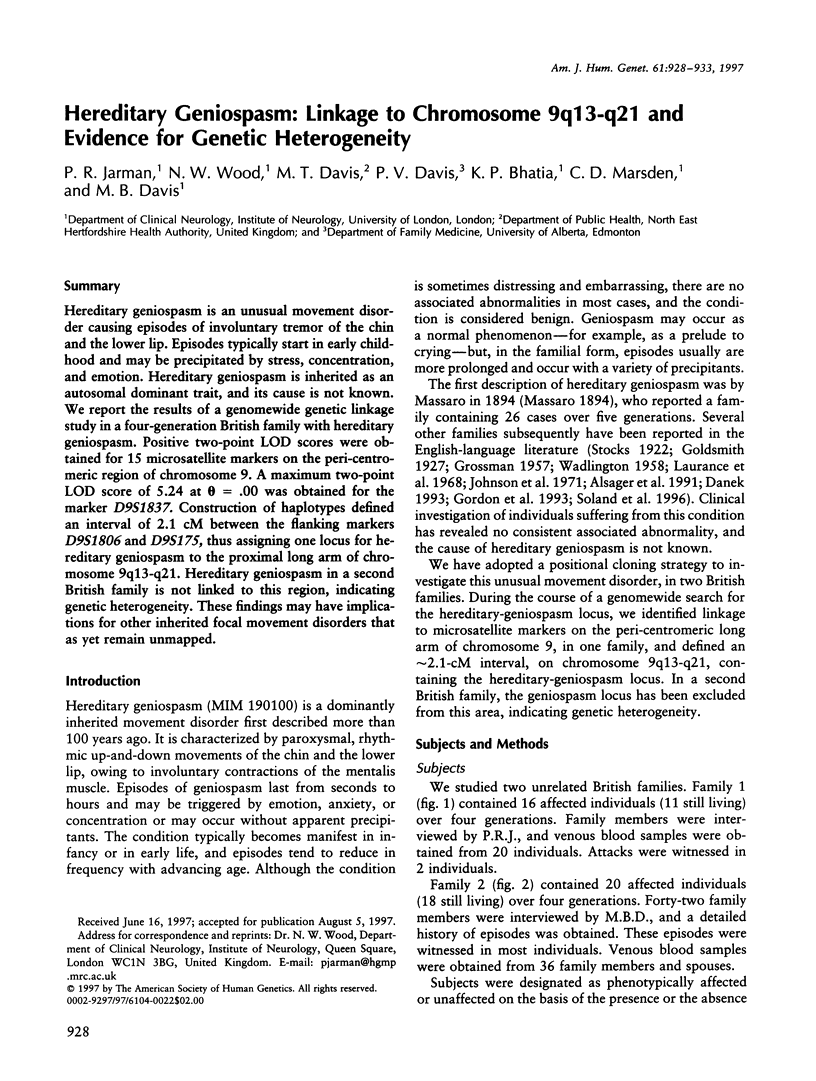
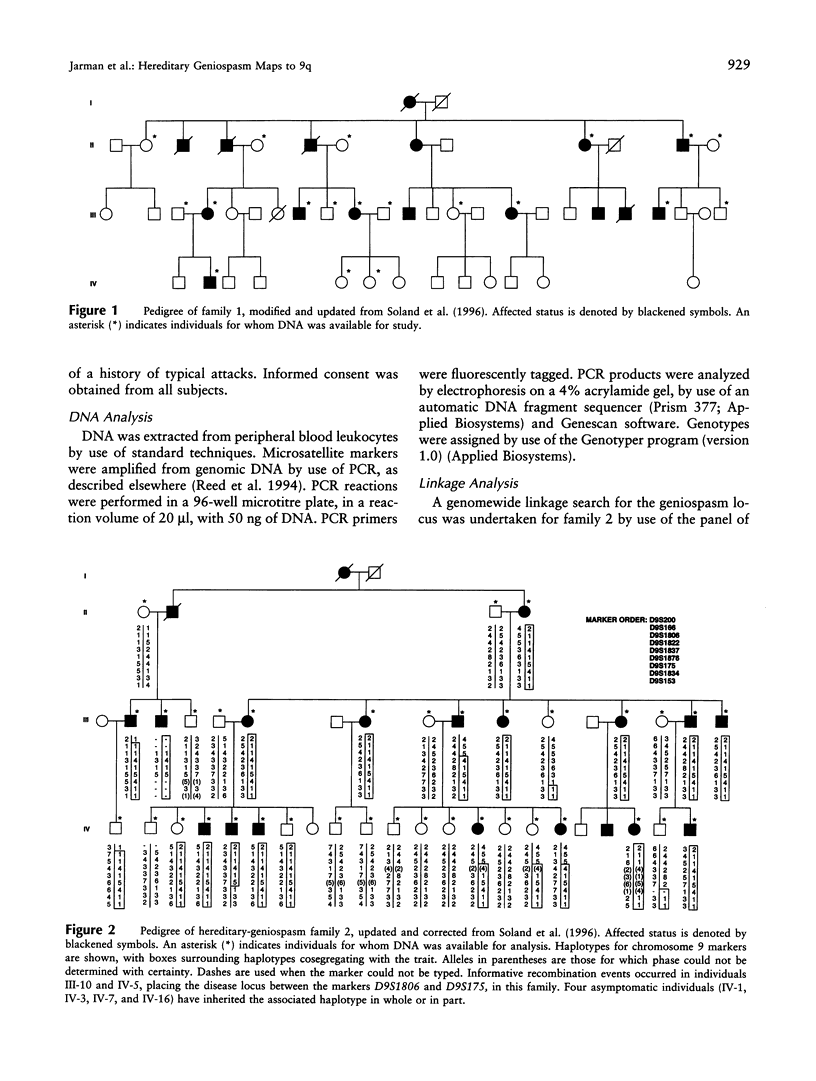
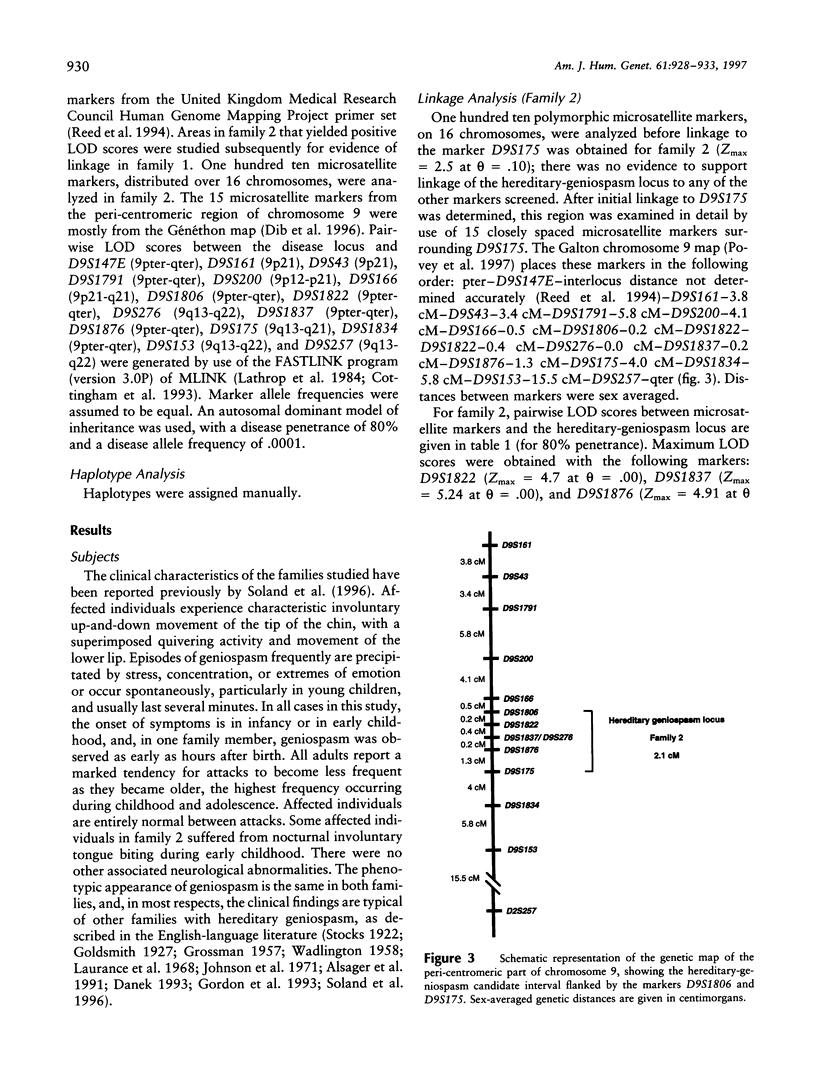
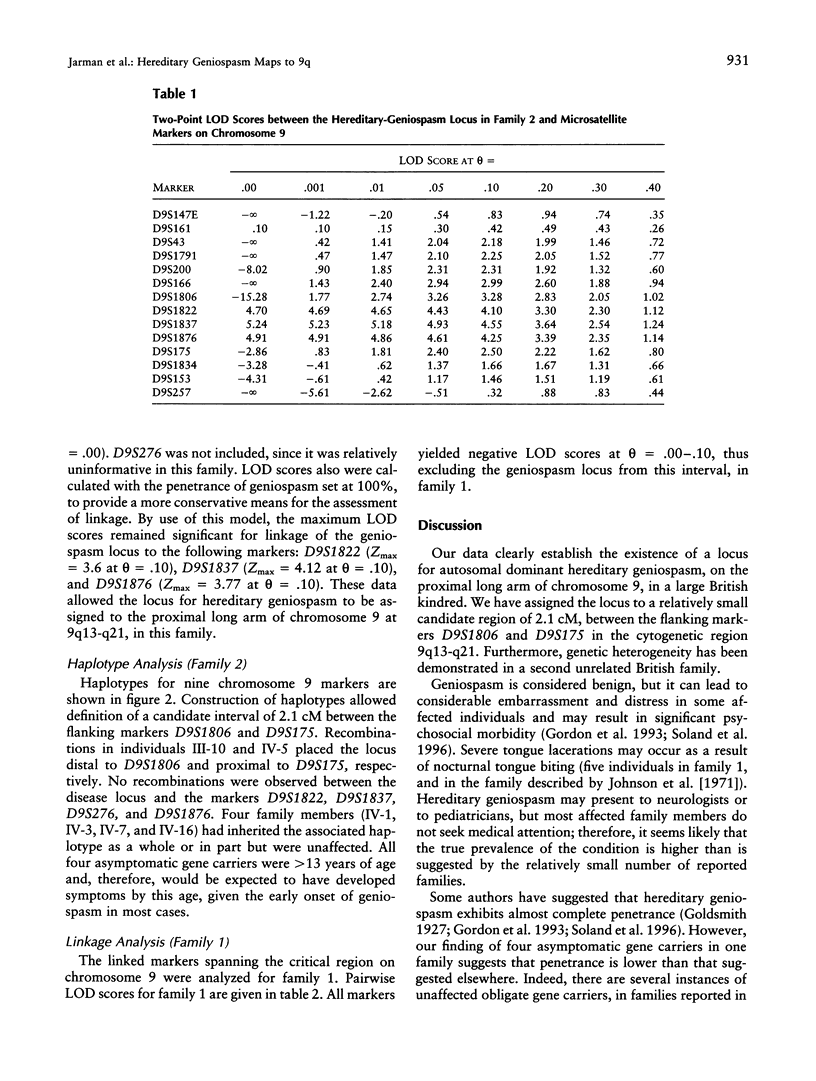
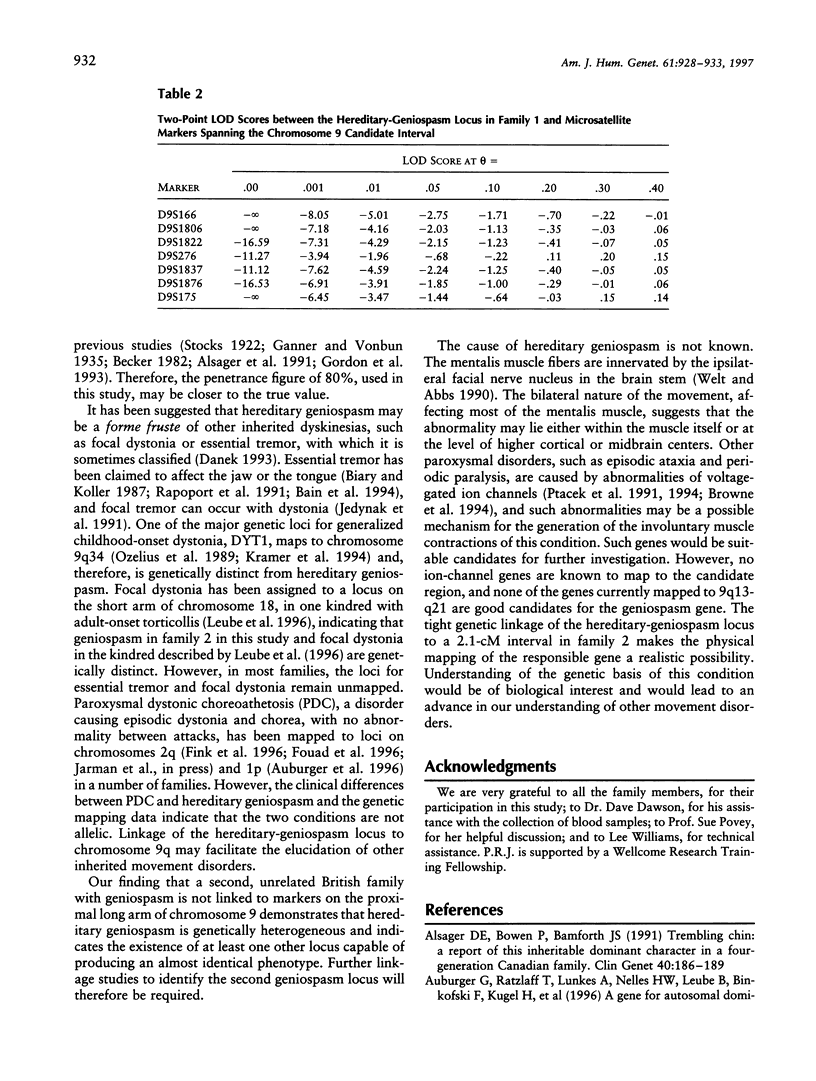
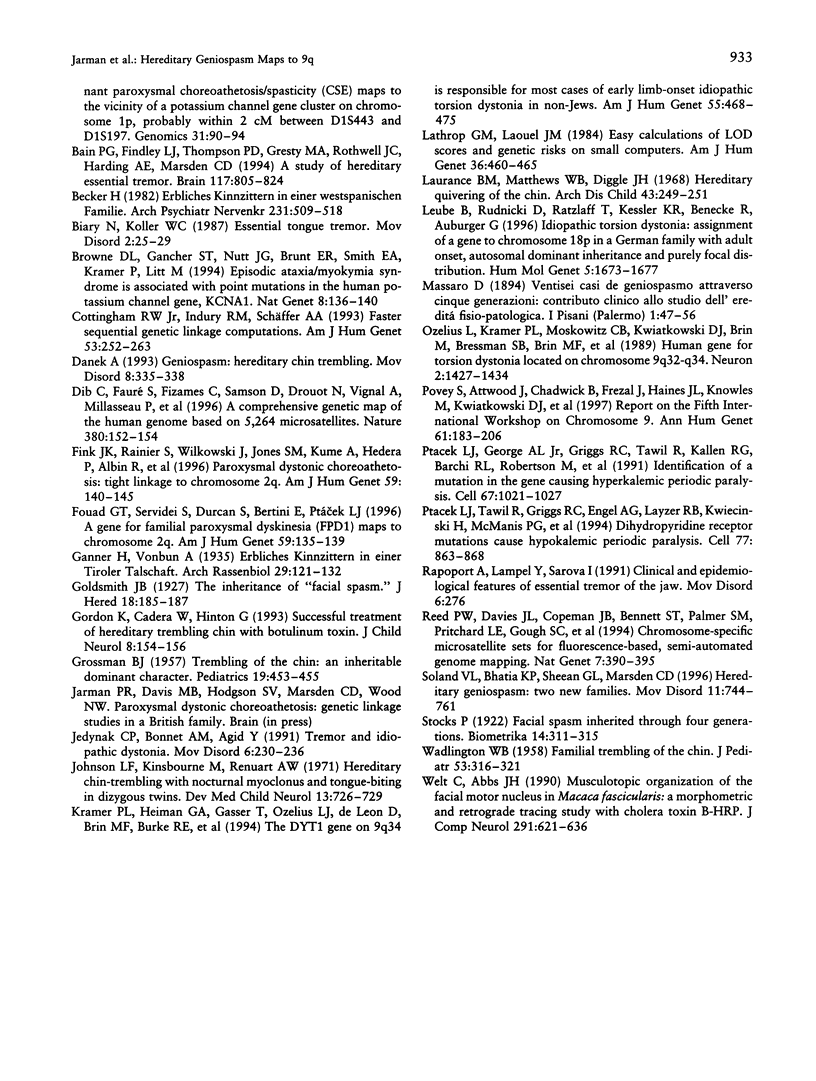
Selected References
These references are in PubMed. This may not be the complete list of references from this article.
- Alsager D. E., Bowen P., Bamforth J. S. Trembling chin--a report of this inheritable dominant character in a four-generation Canadian family. Clin Genet. 1991 Sep;40(3):186–189. doi: 10.1111/j.1399-0004.1991.tb03074.x. [DOI] [PubMed] [Google Scholar]
- Auburger G., Ratzlaff T., Lunkes A., Nelles H. W., Leube B., Binkofski F., Kugel H., Heindel W., Seitz R., Benecke R. A gene for autosomal dominant paroxysmal choreoathetosis/spasticity (CSE) maps to the vicinity of a potassium channel gene cluster on chromosome 1p, probably within 2 cM between D1S443 and D1S197. Genomics. 1996 Jan 1;31(1):90–94. doi: 10.1006/geno.1996.0013. [DOI] [PubMed] [Google Scholar]
- Bain P. G., Findley L. J., Thompson P. D., Gresty M. A., Rothwell J. C., Harding A. E., Marsden C. D. A study of hereditary essential tremor. Brain. 1994 Aug;117(Pt 4):805–824. doi: 10.1093/brain/117.4.805. [DOI] [PubMed] [Google Scholar]
- Becker H. Erbliches Kinnzittern in einer westspanischen Familie. Arch Psychiatr Nervenkr (1970) 1982;231(6):509–518. doi: 10.1007/BF00343994. [DOI] [PubMed] [Google Scholar]
- Biary N., Koller W. C. Essential tongue tremor. Mov Disord. 1987;2(1):25–29. doi: 10.1002/mds.870020103. [DOI] [PubMed] [Google Scholar]
- Browne D. L., Gancher S. T., Nutt J. G., Brunt E. R., Smith E. A., Kramer P., Litt M. Episodic ataxia/myokymia syndrome is associated with point mutations in the human potassium channel gene, KCNA1. Nat Genet. 1994 Oct;8(2):136–140. doi: 10.1038/ng1094-136. [DOI] [PubMed] [Google Scholar]
- Cottingham R. W., Jr, Idury R. M., Schäffer A. A. Faster sequential genetic linkage computations. Am J Hum Genet. 1993 Jul;53(1):252–263. [PMC free article] [PubMed] [Google Scholar]
- Danek A. Geniospasm: hereditary chin trembling. Mov Disord. 1993 Jul;8(3):335–338. doi: 10.1002/mds.870080314. [DOI] [PubMed] [Google Scholar]
- Dib C., Fauré S., Fizames C., Samson D., Drouot N., Vignal A., Millasseau P., Marc S., Hazan J., Seboun E. A comprehensive genetic map of the human genome based on 5,264 microsatellites. Nature. 1996 Mar 14;380(6570):152–154. doi: 10.1038/380152a0. [DOI] [PubMed] [Google Scholar]
- Fink J. K., Rainer S., Wilkowski J., Jones S. M., Kume A., Hedera P., Albin R., Mathay J., Girbach L., Varvil T. Paroxysmal dystonic choreoathetosis: tight linkage to chromosome 2q. Am J Hum Genet. 1996 Jul;59(1):140–145. [PMC free article] [PubMed] [Google Scholar]
- Fouad G. T., Servidei S., Durcan S., Bertini E., Ptácek L. J. A gene for familial paroxysmal dyskinesia (FPD1) maps to chromosome 2q. Am J Hum Genet. 1996 Jul;59(1):135–139. [PMC free article] [PubMed] [Google Scholar]
- GROSSMAN B. J. Trembling of the chin; an inheritable dominant character. Pediatrics. 1957 Mar;19(3):453–455. [PubMed] [Google Scholar]
- Gordon K., Cadera W., Hinton G. Successful treatment of hereditary trembling chin with botulinum toxin. J Child Neurol. 1993 Apr;8(2):154–156. doi: 10.1177/088307389300800208. [DOI] [PubMed] [Google Scholar]
- Jedynak C. P., Bonnet A. M., Agid Y. Tremor and idiopathic dystonia. Mov Disord. 1991;6(3):230–236. doi: 10.1002/mds.870060307. [DOI] [PubMed] [Google Scholar]
- Johnson L. F., Kinsbourne M., Renuart A. W. Hereditary chin-trembling with nocturnal myoclonus and tongue-biting in dizygous twins. Dev Med Child Neurol. 1971 Dec;13(6):726–729. doi: 10.1111/j.1469-8749.1971.tb08344.x. [DOI] [PubMed] [Google Scholar]
- Kramer P. L., Heiman G. A., Gasser T., Ozelius L. J., de Leon D., Brin M. F., Burke R. E., Hewett J., Hunt A. L., Moskowitz C. The DYT1 gene on 9q34 is responsible for most cases of early limb-onset idiopathic torsion dystonia in non-Jews. Am J Hum Genet. 1994 Sep;55(3):468–475. [PMC free article] [PubMed] [Google Scholar]
- Lathrop G. M., Lalouel J. M. Easy calculations of lod scores and genetic risks on small computers. Am J Hum Genet. 1984 Mar;36(2):460–465. [PMC free article] [PubMed] [Google Scholar]
- Laurance B. M., Matthews W. B., Diggle J. H. Hereditary quivering of the chin. Arch Dis Child. 1968 Apr;43(228):249–251. doi: 10.1136/adc.43.228.249. [DOI] [PMC free article] [PubMed] [Google Scholar]
- Leube B., Rudnicki D., Ratzlaff T., Kessler K. R., Benecke R., Auburger G. Idiopathic torsion dystonia: assignment of a gene to chromosome 18p in a German family with adult onset, autosomal dominant inheritance and purely focal distribution. Hum Mol Genet. 1996 Oct;5(10):1673–1677. doi: 10.1093/hmg/5.10.1673. [DOI] [PubMed] [Google Scholar]
- Ozelius L., Kramer P. L., Moskowitz C. B., Kwiatkowski D. J., Brin M. F., Bressman S. B., Schuback D. E., Falk C. T., Risch N., de Leon D. Human gene for torsion dystonia located on chromosome 9q32-q34. Neuron. 1989 May;2(5):1427–1434. doi: 10.1016/0896-6273(89)90188-8. [DOI] [PubMed] [Google Scholar]
- Povey S., Attwood J., Chadwick B., Frezal J., Haines J. L., Knowles M., Kwiatkowski D. J., Olopade O. I., Slaugenhaupt S., Spurr N. K. Report on the Fifth International Workshop on Chromosome 9 held at Eynsham, Oxfordshire, UK, September 4-6, 1996. Ann Hum Genet. 1997 May;61(Pt 3):183–206. doi: 10.1046/j.1469-1809.1997.6130183.x. [DOI] [PubMed] [Google Scholar]
- Ptácek L. J., George A. L., Jr, Griggs R. C., Tawil R., Kallen R. G., Barchi R. L., Robertson M., Leppert M. F. Identification of a mutation in the gene causing hyperkalemic periodic paralysis. Cell. 1991 Nov 29;67(5):1021–1027. doi: 10.1016/0092-8674(91)90374-8. [DOI] [PubMed] [Google Scholar]
- Ptácek L. J., Tawil R., Griggs R. C., Engel A. G., Layzer R. B., Kwieciński H., McManis P. G., Santiago L., Moore M., Fouad G. Dihydropyridine receptor mutations cause hypokalemic periodic paralysis. Cell. 1994 Jun 17;77(6):863–868. doi: 10.1016/0092-8674(94)90135-x. [DOI] [PubMed] [Google Scholar]
- Reed P. W., Davies J. L., Copeman J. B., Bennett S. T., Palmer S. M., Pritchard L. E., Gough S. C., Kawaguchi Y., Cordell H. J., Balfour K. M. Chromosome-specific microsatellite sets for fluorescence-based, semi-automated genome mapping. Nat Genet. 1994 Jul;7(3):390–395. doi: 10.1038/ng0794-390. [DOI] [PubMed] [Google Scholar]
- Soland V. L., Bhatia K. P., Sheean G. L., Marsden C. D. Hereditary geniospasm: two new families. Mov Disord. 1996 Nov;11(6):744–746. doi: 10.1002/mds.870110626. [DOI] [PubMed] [Google Scholar]
- WADLINGTON W. B. Familial trembling of the chin. J Pediatr. 1958 Sep;53(3):316–321. doi: 10.1016/s0022-3476(58)80218-8. [DOI] [PubMed] [Google Scholar]
- Welt C., Abbs J. H. Musculotopic organization of the facial motor nucleus in Macaca fascicularis: a morphometric and retrograde tracing study with cholera toxin B-HRP. J Comp Neurol. 1990 Jan 22;291(4):621–636. doi: 10.1002/cne.902910409. [DOI] [PubMed] [Google Scholar]


